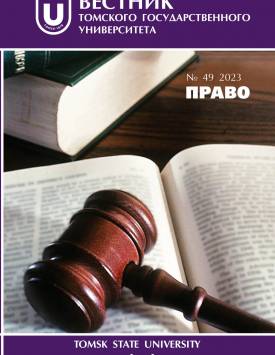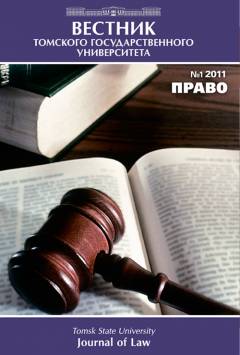Criminological characteristics of repeated crimes committed by those sentenced to punishments not related to isolation from society
The authors of the article argue that the effectiveness of the system of measures to prevent repeat offences committed by prisoners sentenced to punishments unrelated to isolation from society depends on many both subj ective and obj ective criminological factors. However, the authors of the study believe that a special role in the issue of increasing the effectiveness of preventive measures is played by a comprehensive criminological analysis of repeat offences among convicts of the category under consideration, which in turn allows to identify a number of features unique to this type of crime. In conducting the criminological analysis, the authors used empirical material obtained in the course of a more in-depth study of repeat offences among convicts. The empirical data included statistical data from the GIAC of the Ministry of Internal Affairs of Russia, reflecting the general state of crime in the country, as well as statistical data from the Federal Penitentiary Service of Russia, presented by some regions of the Siberian Federal District (Altai Krai, Altai Republic, Omsk Oblast). The authors analysed repeated crimes committed by such categories of convicts as: those conditionally sentenced; those sentenced to deprivation of the right to hold certain positions or to engage in certain activities; those sentenced to restriction of liberty; those sentenced to compulsory labour; and those sentenced to correctional labour, who in turn are registered with the branches of the penal correctional institutions of the Federal Penitentiary Service of the Federal Penitentiary Service of Russia in the regions considered above. In the course of the study, the authors have identified the following trends in repeat offences among those sentenced to punishment without isolation from society: 1. high dependence on regionality, i.e. the level of repeat offences is largely influenced by the specifics of development of a particular region in which the person under custody committed a repeat offence; 2. persisting tendency of a high proportion of repeat offences (more than 25%) committed by registered convicts in the first three months from the moment of their registration with the Penal Enforcement Institute; 3. the continuing trend of a high proportion of "repeat offences" among drunken convicts. More than 40% of all repeat offences committed by convicts were committed under the influence of alcohol; 4. repeat offences committed by under-account convicts have an average level of latency; 5. repeated crimes committed by convicts have a lower degree of criminological professionalism. According to the authors of this article, the presence of the most complete criminological characteristics of repeat offences, contributes to the development of a better and more effective system of prevention measures applied to this category of convicts. The authors declare no conflicts of interests.
Keywords
criminological characteristics of repeated crimes, convicts, criminal enforcement inspectionAuthors
| Name | Organization | |
| Detkov Alexey P. | Altai State University | detkov-altai@yandex.ru |
| Dorozhinsky Arthur A. | Barnaul Law Institute of the Ministry of Internal Affairs of Russia | dorozhinskii-1995@mail.ru |
References

Criminological characteristics of repeated crimes committed by those sentenced to punishments not related to isolation from society | Tomsk State University Journal of Law. 2023. № 49. DOI: 10.17223/22253513/49/3
